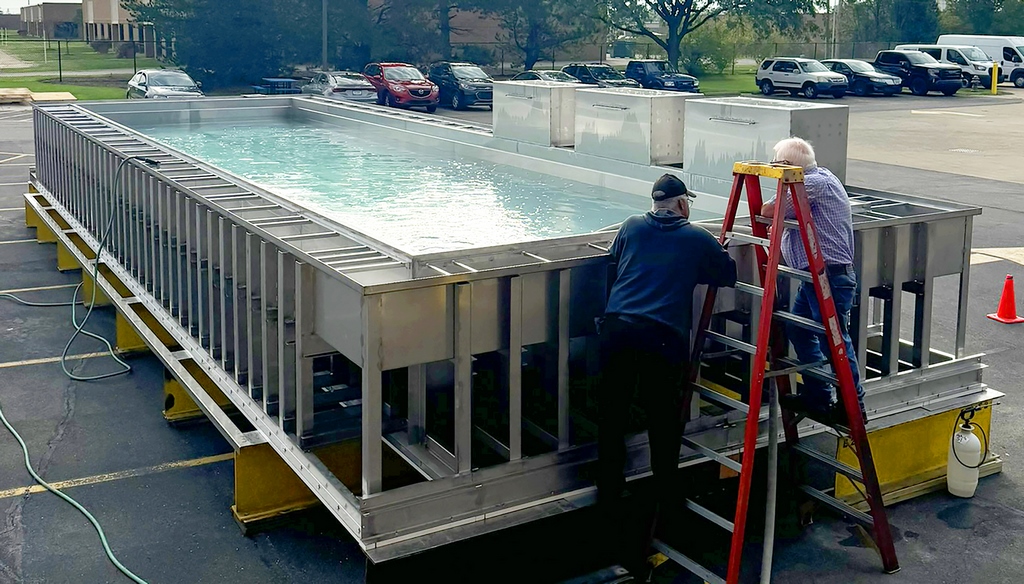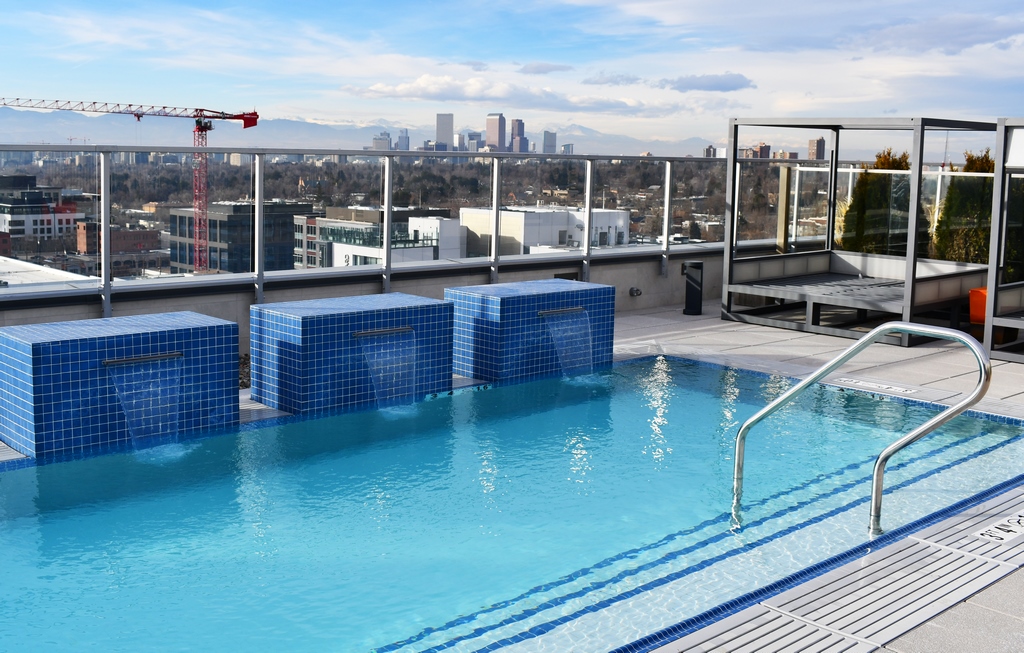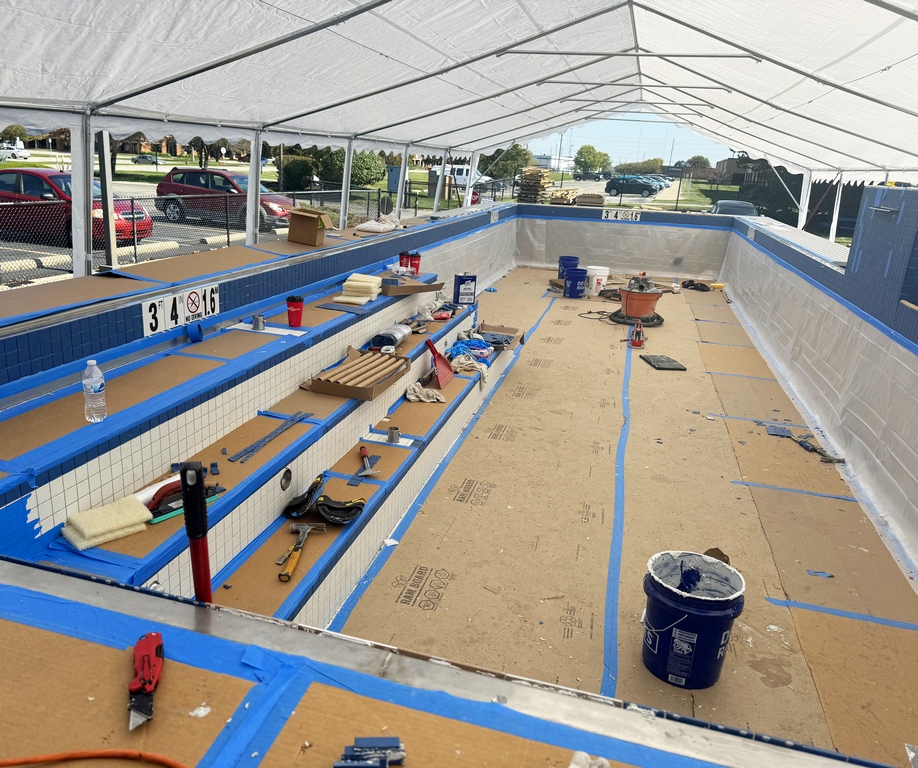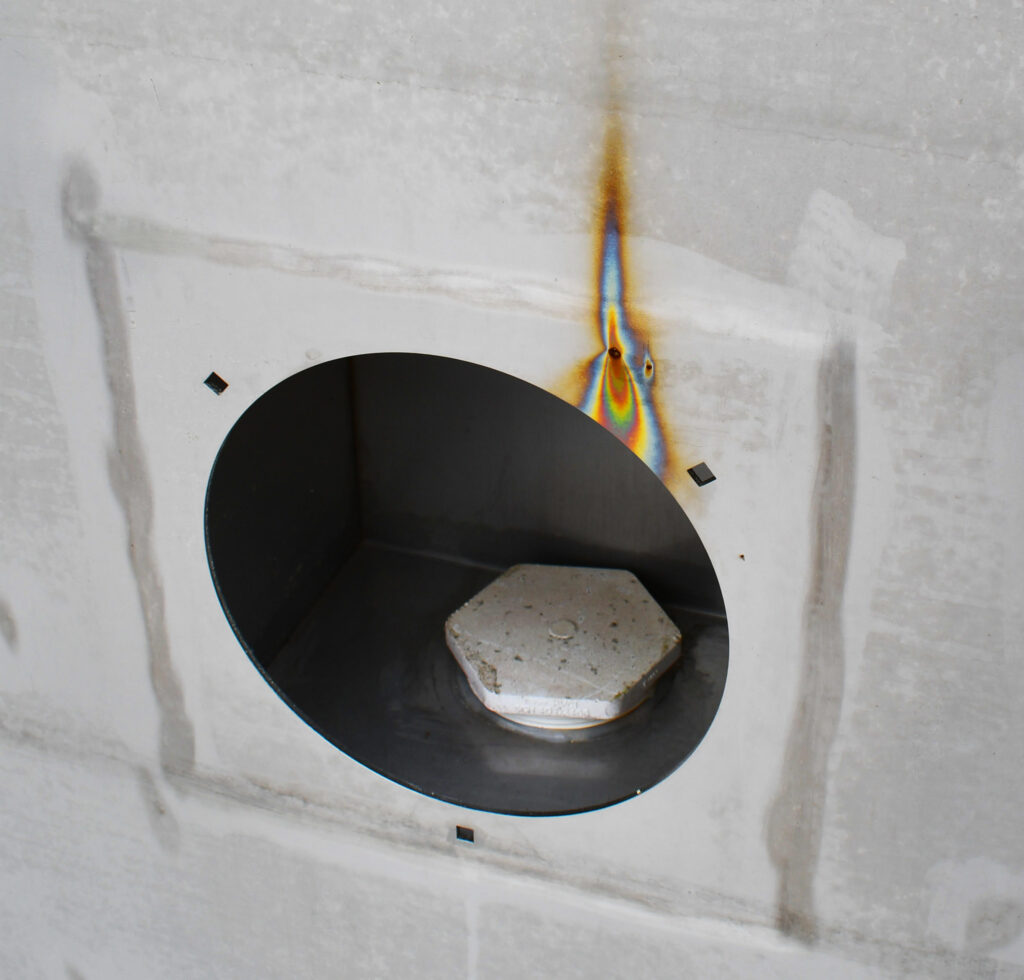Stainless Watershapes (Part I)


Stainless-steel vessels have dramatically increased in popularity over the past 20 years, observes Mark Holden and Jeff Freemen. That increase necessitates a greater understanding of the material, its advantages and, as important, the potential problems associated with the manufacturing process that can lead to catastrophic failures, litigation and expensive remediations.
By Mark Holden & Jeff Freeman
We have been writing about stainless steel watershapes for over 15 years. Some articles were about failures and others about the ins-and-outs of how to work with the material. Our last discussion centered on stray current.
This time around, we want to pull back the curtain on what watershapers should know when working with stainless steel vessels, and how they should organize the process of implementing these vessels into a project in a highly professional manner. Too often (or even most of the time that we’ve seen), this process is left to chance and the results range from highly problematic and sometimes catastrophic.
Concrete has typically been the structural material for creating watershapes; but, with modern advances in material invention and fabrication, alternate means of creating these vessels have become a common place staple for many architectural scenarios. Stainless steel was once a novelty for this purpose but has become a superior material over the last twenty to thirty years.
In our experience, specifically with interior and overstory watershapes, we have seen mostly concrete pools set within a concrete vault 15-20 years ago (80% concrete vs. 20% stainless steel). Currently, we find that this ratio is reversed and that about 80-90% of overstory vessels are manufactured from stainless steel. That’s a monumental shift that necessitates greater understanding of these structures.
With this new-found direction, there exists a wide range of material and fabrication qualities that are presented to projects, and those differences make these vessels either a wonderful experience or a litigious nightmare, causing a rehabilitation process that can double, triple or quadruple the original installation costs.
Currently, there are little-to-no quality standards in the watershape industry for stainless steel material and/or craftsmanship quality. As a result, we are frequently retained for forensic and expert testimony services to help solve these inconsistencies and leave revived watershapes wherever we can.
UNDERSTANDING THE ISSUES
When stainless steel fails, it is something like an organic disease. Corrosion is far and away the most common issue and it can start due to a variety of reasons that we will address later. It typically is a growing process that is only suspended with elimination of the cause, followed by rehabilitation of the materials.
Without effective mitigation, the damage grows and with it, the momentum toward litigation. The prevailing belief within the watershape stainless-steel industry is that there is no problem, and therefore, nothing to improve upon. We contend that is a false assertion, based largely on profits.
Why is corrosion the primary failure of stainless steel watershapes? The main reason is the metal has a very thin surface barrier of chromium oxide that helps prevent corrosion. When that layer is compromised, corrosion commences and typically does not stop until it is halted by outside forces. There are about a half a dozen types of events that cause corrosion, and they vary widely from their source. We will go into these below as part of the list of things to watch out for.

This project in Denver, CO, is an example of the customizable potential of overstory stainless steel projects.
What remains is the need to analyze the current industry quality-control standard and practices, and compare this to the realities of metallurgy science, which is very specific but not well understood in our industry. In our forensic work, we employ the perspective of various industries, such as nautical, pharmaceutical, and the fundamental science behind historic science greats, such as Michael Faraday, who was instrumental in advancing the understanding of electromagnetism and electrochemistry.
After years of experience examining multiple projects, we have come to believe that simple fabrication tests can be performed following the welding process. These are often are not attended to in lieu of getting product out the door.
When a vessel is fabricated and shipped from the manufacturer, there is no telling what level of quality control has been performed. As an example, last year, we saw a pool that arrived onto a rooftop site in downtown Beverly Hills that was covered with heat tinge, incomplete welds and generally unpassivated surfaces, which is entirely unacceptable and certainly prone to failure.
Afterwards, we chose to eliminate that situation with a visit to a leading manufacturer to observe a vessel that we had designed to replace a failed stainless shell that we forensically found to be a complete failure in the Denver, CO area.
The replacement shell was welded, ground, cleaned, passivated, hydrotested and drained prior to our arrival, everything we would hope for. Due to the high-quality control of this fabrication process, we found absolutely no compromised areas within the interior of the vessel and only miniscule heat tinge on the exterior in areas that will never affect the watershape.
From this process we reaffirmed our belief that all stainless shells need consistent manufacturer quality control. We assertThe industry needs to implement their own QC or the design trades will have to in the endeavor of ensuring great watershapes.
STAINLESS STANDARDS
There are standards for stainless steel materials and welding within aqueous environments, but they often are not implemented within the watershape industry. They typically only reside in shipbuilding and processing systems. It seems extremely odd that someone would put fifty to a hundred thousand gallons of water on top of a building and not put tight measures in place to ensure that it will not fail. This will need to change to allow stainless steel to flourish in the watershaping industry.
If you are going to pay a half million to multimillion dollar invoice for a stainless watershape, then it is obvious that you should learn more about what you, and the client, are paying for and what headaches you will endure if your design and fabrication choices are made in haste. The product can corrode, leak and eventually take out many floors of construction in an overstory project. The potential liability is enormous and many professionals are oblivious to how it can affect them until it’s too late.
Education of the end-users and watershapers is the single most important factor in ensuring that stainless-steel watershapes are fabricated and installed to a high quality level. Most property owners, architects, general contractors and specialty installers have little to no background in what makes a competent stainless steel watershape.
As soon as we explain sub-par fabrication and/or materials, every single one of these professionals immediately wants the highest level of quality, even if they were never able to obtain such in past projects. The old adage of a person’s mind stretched by a new idea can never go back to its original size, perfectly describes our experience with this topic. Once anyone knows what substandard work is, they demand exceptional work every time after.
Our suggestion is that all watershapers must become more knowledgeable in the correct implementation of stainless to help educate the entire watershaping industry, since it will not come from other sources. With that said, there are fabricators that seem to strive for greater accomplishments; but, even today with major fabricators, we see both great work and that sub-par performance mentioned earlier.
COMMON CORROSION TYPES

Overstory stainless steel vessels require an especially precise approach to installation, and especially with waterproofing and leak control
Keeping a watchful eye out for potential problems first means understanding the most common types of failure, usually related to corrosion. Below are the major types of corrosion that can be found within stainless steel vessels that watershapers should look for:
- Galling: This type of corrosion occurs when stainless components are forced together. This is commonly observed when nuts, bolts, and other fasteners are used, and corrosion isn’t visible until the parts are separated or disassembled.
- Galvanic: This occurs when two dissimilar metals are in touch around moisture, especially when there is any stray current. The less noble, or less stable, metal will typically start the corrosion process first.
- Pitting: This is typically seen when corrosive chemicals are exposed to the steel with poor aeration and defects in fabrication. Chloride concentration, temperature and pH can affect this process.
- Crevice Corrosion: Small spaces under tile in fittings and in pool welds that prevent adequate oxygenation around the stainless can cause this process. Good design of the vessel and proper circulation is essential.
- Weld Decay: This corrosion, often called heat tinge, results from heating stainless being welded at a certain temperature (often between 1,000F and 1,500F). This causes the thin chromium layer to be compromised and requires cleaning, pickling and passivating to reestablish this vital layer.
AREAS OF CONCERN
When watershaping with stainless, aside from identifying corrosion types, there are other extremely important areas to consider. Besides the basic grade of the metal (always use grade 316L minimum for everything), there are factors that will gauge whether your watershape is successful or not. Ignoring any of these seems ridiculous since most of the solutions to a successful watershape are simple if implemented before a problem starts. Consider them vitamins for a healthy watershape.
- Dual Containment: We have seen many overstory projects where stainless watershapes have been attempted to be set within a wood-framed building with no outside containment to control any condensation or failures in the vessel. It should be self-evident that whether a watershape is metal or concrete, locating one in a wood-framed structure without any way to drain away water is ludicrous especially when any failure is catastrophic. In this scenario, either a stainless secondary containment pan is needed, or preferably a concrete vault with waterproofing—both require drains to relieve any condensation from the outside of the shell or from potential fittings or corroded stainless.
- Weld Materials: As mentioned above, galvanic corrosion can occur when two dissimilar metals are adjacent. The more noble metal robbing properties from the lesser. As such, stainless watershapes should have similar metals in their assembly to mitigate corrosion. Again, steel in watershapes should be grade 316L. Likewise, the welding rod or joint material should also be the same grade, and #304 grade welding rods should never be used.
- EMF/Stray Current: Electromagnetic Fields (EMF) can come from many sources especially with a building structure where there are motors or high voltage sources. Electrical panels, transformers, motors or even from static electricity generated from natural events can create these fields. We diagnosed a major project many years ago from an underground electrically powered passenger train that transferred 14,000 volts up into a building every seventeen minutes. The big takeaway then and now is that stray current is everywhere, and it is important on how to control it.
- Cathodic Prevention: Stray current can be controlled by means of cathodic protection. There are active and passive cathodic directions for this but the latter is the more reasonable for most watershapes. Stray current will find a home in the least noble, or least resistant to corrosion, metal on a watershape. Most, if not all, boats and ships have sacrificial anodes that absorb this stray current that can come from the very sea vessel needing the protection. In watershapes, a simple addition of magnesium or zinc—less noble metals—anode set within a niche on the walls of watershapes can take the brunt of stray current and help protect a watershape instead of letting that current slowly eat away at substandard welds or compromised areas of the vessel.
- Pickling/Passivating: After a stainless watershape is welded, the welds need grinding and cleaning. Once smooth from grinding, the smoothed-out surface needs a process to get that chromium oxide layer to reform on the surface of the metal. Pickling is a process that should remove impurities and typically is in the form of an acidic solution. Passivating is actually a process or trying to make the metal more ‘passive’ to corrosion. This part of the process is where the magic layer is reformed on the steel. Without both, there is a substandard stainless watershape. It must happen on all watershapes prior to hydrotesting and installation of finish materials.
- Hydrotesting: Once all the major protections have been implemented, it is time to test the validity of our work. Hydrotesting is a very simple process of simply filling a stainless watershape with water that contains some chlorides and letting it sit for a period of time, then drain it and see what goes wrong. This editing of our work allows us greater assurance that the delivered watershape is of a higher caliber. After the watershape is drained, and allowed to sit for a day or two dry, corrosion will start to form on any compromised areas. This single last chance to catch mistakes is essential. Without this simple measure, there is a much higher risk of failure.
WHAT TO DO?
Because we have seen so much inconsistency in the quality of stainless-steel pool manufacturing, the answer for watershapers seeking to utilize these vessels, especially in overstory applications, is to know what to look for and what questions to ask suppliers.
We’ll get into those recommendations in Part II of this two-part series outlining what you need to know to work effectively as a stainless watershaper.
Mark Holden is a licensed landscape architect and contractor, a university-level instructor, writer and forensic expert in the water industry for over thirty years. His firm, Holdenwater in Fullerton, CA, addresses the design, engineering and forensics of water environments ([email protected]).
Jeff Freeman has been a leader and innovator in the water-quality industry for over 30 years. In addition to lecturing and guiding agency regulatory policy, he has dedicated his career to advancing the technology of water purification and sanitization. He is Certified Pool Operator (CPO) and has U.S. military certification for water environments. ([email protected]).
Opening photo: hydrotesting a stainless steel watershape, courtesy of Natare Corp.










